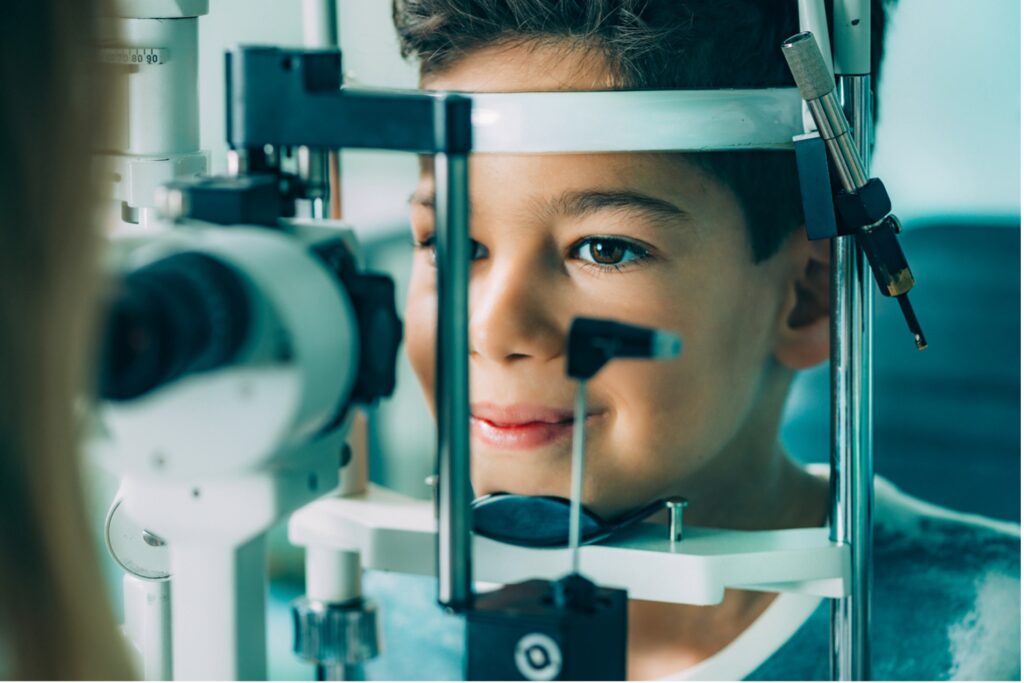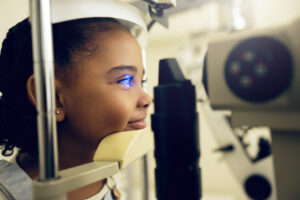In the busy world of childhood, where each day unfolds with new adventures and constant learning, maintaining clear vision is essential. Welcome to Alice Family Eye Center, where we understand the significance of children’s eyesight in exploring the world, absorbing information, and engaging in crucial developmental activities. Despite its importance, vision problems in kids can easily slip under the radar, potentially impeding academic progress, social interactions, and overall well-being. Thus, it is imperative for parents and caregivers to remain vigilant in detecting vision problems in children early on.
The Importance of Early Detection
The CDC (Centers for Disease Control) urges parents to take their children in for recommended eye exams:
“Your child’s vision helps them take in the world around them. But it also plays an important role in their development. If your child has an uncorrected vision problem, it may affect their ability to learn and reach their highest potential. Having a routine eye exam is important to keep their eyes healthy.”
Learning can be exceedingly difficult for children who cannot see well.. Academic or behavioral challenges in children may sometimes stem from underlying vision issues.
Children often will not recognize or communicate vision problems since they assume their vision is normal. As such, parents, caregivers, and educators must observe signs indicating underlying vision issues. Timely detection is crucial because early intervention can prevent long-term complications and support healthy visual development.
Signs of Vision Problems in Children

1. Squinting or Closing One Eye
If you notice your child frequently squinting or closing one eye to see objects clearly, it could indicate a refractive error like nearsightedness or farsightedness.
2. Frequent Eye Rubbing
Excessive eye rubbing might signal eye fatigue, strain, allergies, or irritation.
3. Headaches or Eye Pain
Persistent headaches, especially after reading or focusing on close-up tasks, could indicate eye strain or other vision issues.
4. Difficulty Concentrating or Short Attention Span
Children with undiagnosed vision problems may find it challenging to concentrate on tasks that require visual attention, such as reading or completing puzzles.
5. Sitting Close to the TV or Holding Books Close to the Face
While it is common for children to be curious and get close to objects, consistently sitting too close to the TV or holding books near their faces might indicate vision difficulties.
6. Avoidance of Reading or Screen Time
Children who avoid activities that require visual concentration may be doing so because they find them uncomfortable or challenging due to vision problems.
If you notice these signs, bring your child in for a pediatric eye exam. Our optometrists at Alice Family eye center are trained in pediatric eye care and can get to the root of the problem. Even if you do not notice these signs, bringing your child in for an exam or ensuring their pediatrician performs a vision screening is essential. Catching a problem early and being proactive can help ensure eye health as the child ages. Once a vision problem is corrected, this could positively affect academic performance and behavior.
Steps to Address Vision Problems in Children

1. Schedule Regular Eye Exams
Routine eye examinations are fundamental for early detection of vision problems. Pediatricians recommend that children receive their first comprehensive eye exam at around six months, additional exams at ages three and five, andannual exams after that.
2. Promote Healthy Vision Habits
As we covered in our blog Protect Your Family’s Eyes: How Blue Light Affects Vision, children are especially vulnerable to the effects of blue light due to their developing eyes. Increased screen exposure at a young age can contribute to digital eye strain, dry eyes, and other vision problems. To protect children’s eyes from blue light, limit screen time and encourage children to take breaks during prolonged screen time or reading periods to reduce eye strain. The 20-20-20 rule—taking a 20-second break to look at something 20 feet away every 20 minutes—can help alleviate eye fatigue.
3. Ensure Proper Lighting
Adequate lighting and ergonomic setups can reduce eye strain and promote comfortable reading and studying environments. Ensure your child’s workspace is well-lit and maintain an appropriate distance from screens and books. Follow the elbow rule: have them keep an elbow-to-hand distance away from books and screens to avoid them being too close to the eyes.
4. Provide Protective Eyewear
If your child participates in sports or activities that pose a risk of eye injury, ensure they wear appropriate protective eyewear. Sports goggles or helmets with visors can help prevent serious eye injuries during physical activities.
5. Provide Children with Sunglasses
Sunglasses are essential for kids as they provide crucial protection against harmful UV rays, safeguarding their delicate eyes from potential damage. Children spend significant time outdoors, increasing their exposure to sunlight. Sunglasses designed specifically for children offer UV protection, reducing the risk of conditions like cataracts and macular degeneration later in life. Additionally, sunglasses help prevent glare and bright sunlight discomfort, promoting outdoor enjoyment and ensuring children’s visual comfort.
6. Address Vision Issues Promptly
If your child is diagnosed with a vision problem, such as nearsightedness, farsightedness, or astigmatism, follow your eye care professional’s recommendations for corrective measures, including glasses, contact lenses, or vision therapy.
7. Promote a Balanced Lifestyle
Encourage outdoor play and activities that stimulate overall health and well-being. Spending time outdoors has been associated with a reduced risk of myopia (nearsightedness) in children.
8. Provide a Healthy, Balanced Diet
A healthy, balanced diet with a variety of fruits, vegetables, whole grains, lean proteins, and dairy products in a child’s diet ensures they receive the necessary nutrients vital for maintaining good eye health and promoting proper visual development.
Conclusion: Giving A Child the Gift of Sight
Children’s eye health is vital to their overall well-being and development. By remaining vigilant for signs of vision problems and prioritizing regular eye exams, parents and caregivers can help children have the vision they need to thrive academically, socially, and physically. By fostering healthy vision habits and addressing issues promptly, we can empower our children to explore the world with clarity and confidence, setting the stage for a lifetime of visual wellness.
Schedule a Pediatric Eye Exam with our eye doctor at Alice Family Eye Center in Alice, TX
Call Alice Family Eye Center today at (361) 668-3937 for more information or to schedule a pediatric eye exam.





